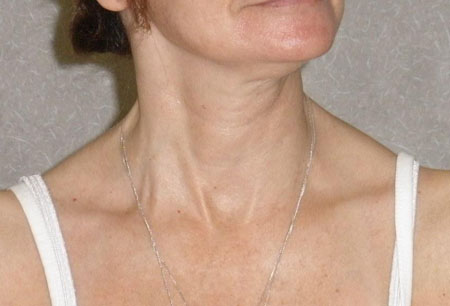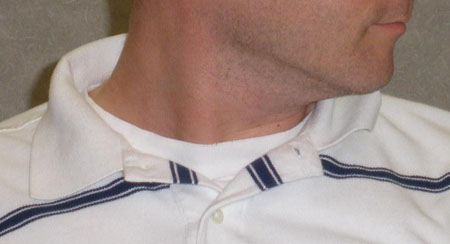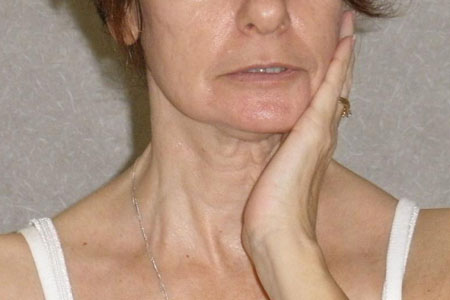History and exam
Key diagnostic factors
common
involuntary twisting or deviation of the neck
Patients may express this symptom by complaining about a cramp or spasm in the neck, shoulder, or upper back. This is typically the chief complaint at time of presentation and sufficient indication for treatment to commence.
Patients are usually able to identify a primary direction of involuntary head movement (e.g., twisting to the left and tilting backward).[Figure caption and citation for the preceding image starts]: Patient with moderate left torticollis or neck rotation, mild right laterocollis or lateral neck flexion, and mild retrocollis or neck extensionFrom the collection of Dr David Sommer [Citation ends]. [Figure caption and citation for the preceding image starts]: Patient with severe left torticollis (note hypertrophy of right sternocleidomastoid muscle)From the collection of Dr David Sommer [Citation ends].
[Figure caption and citation for the preceding image starts]: Patient with severe left torticollis (note hypertrophy of right sternocleidomastoid muscle)From the collection of Dr David Sommer [Citation ends].
neck pain
May be diffuse or focal.
Present to some degree in most cases and severe enough to be a source of disability in a significant minority of cases.[15]
May be the chief presenting complaint.
presence of sensory trick
A specific movement that can alleviate symptoms (most commonly touching the face).
The absence of a sensory trick does not rule out the diagnosis, but its presence greatly increases the likelihood of diagnosis, as this is a common and specific feature.[17][Figure caption and citation for the preceding image starts]: Patient using sensory trick with reduction in dystonia severityFrom the collection of Dr David Sommer [Citation ends].
abnormal head posture
The degree of abnormal head posture (torticollis, anterocollis/retrocollis, laterocollis and lateral shift) should be observed and recorded (with and without the use of a sensory trick).
It is important that the patient be relaxed and allow the primary abnormal posture to emerge.
otherwise normal neurologic exam
Observed neurologic abnormalities should raise suspicion of secondary acquired torticollis or an alternative etiology of dystonia.
Other diagnostic factors
common
head tremor
Consists of opposing dystonic and compensatory movements/maneuvers.
This dystonic tremor differs from essential tremor of the head in that typically it is asymmetrical and irregular.[1]
insidious onset
Abrupt onset of dystonia should raise suspicion for nonidiopathic etiologies (e.g., complication of therapy with dopamine receptor-blocking drugs).
headache
Headache pain may be present in some cases.
asymmetrical hypertrophy of neck muscles
Asymmetry should correlate with dominant posture (e.g., sternocleidomastoid is often discernibly hypertrophied).
normal range of motion (ROM) of neck (early in course)
Limited ROM suggests a possible underlying structural cause of dystonia, although in longstanding cases limited ROM can be a secondary complication from the dystonia itself.
Risk factors
weak
female sex
Incidence is 2.5 times higher among women than men.[2]
middle age (40 to 59 years)
Mean age at diagnosis has been found to be 56 years among women and 45 years among men.[2]
white ancestry
A US study showed acquired torticollis to be more common among white people.[2]
family history of acquired torticollis
exposure to dopamine-blocking drugs
May occur as an acute or delayed (tardive) complication of therapy with dopamine receptor-blocking drugs, such as antipsychotics or other dopamine antagonists (e.g., metoclopramide, prochlorperazine).
Tardive dystonia is estimated to occur in 3% of patients treated with long-term antipsychotics.[11]
history of trauma
Association is often reported but is epidemiologically questionable.[10]
Use of this content is subject to our disclaimer